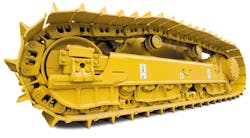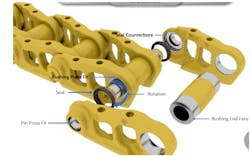New Technology, Practicing Fundamentals Extend Undercarriage Life
Advances in crawler-dozer undercarriage technology might not get the attention that, say, new 3D grade-control packages might receive, but that said, today’s undercarriage systems do incorporate refined designs that can provide extended life and reduce maintenance costs—which, by some estimates, can account for as much as 50 percent of a dozer’s lifetime repair expense. Selecting technology that’s appropriate, keeping the tracks clean and in proper tension, avoiding operating practices that accelerate wear, and scheduling periodic inspection by an undercarriage specialist are the basics of managing this expensive asset.
Most crawler dozers today leave the factory with a sealed-and-lubricated track (SALT ) undercarriage, designed to minimize wear in a particularly vulnerable spot in the system—between the outer diameter of the pin and the inner diameter of the bushing. An oil reservoir in the pin supplies lubricant to the annular space between the pin and bushing via a radial passage, and critical to this design are the seals—positioned in the link counter-bores in a conventional SALT chain—that retain the oil in the pin/bushing joint.
If the seal fails and leaks lubricant, then the joint begins to wear—the result of friction caused by the pin rotating in the bushing, under load, at certain points during the chain’s travel around sprockets and idlers. Typically, because of the forces involved, wear occurs on only one side of the pin and the corresponding inner surface of the bushing.
This wear upsets the chain’s geometry, causing the distance between pin centers (pitch) to increase, allowing the chain to elongate and become loose. Bushings no longer engage the sprocket teeth at an optimum position, accelerating wear on these two components in particular, but generally accelerating wear throughout the system. (Even in a healthy, well-tensioned chain, however, bushings wear as they contact the sprocket, but this normal wear typically occurs on only one side of the bushing.)
Given the importance of retaining oil in the pin/bushing joint, says Caterpillar’s Tim Nenne, senior market professional, the company manufacturers its own proprietary seals and uses only synthetic oil in the pin/bushing joint, a combination, he says, that provides longer oil retention and improved lubrication of these critical track-chain components in demanding applications to gain extended life.
To control wear at another vulnerable spot in undercarriage systems—between bushings and sprocket teeth, Caterpillar has made a further refinement, says Nenne.
“Caterpillar developed and patented Tough-Steel sprocket segments, which can increase bushing life as much as 50 percent,” he says. “Because the sprocket resists abrasion, teeth maintain their shape for an extended interval, and contact between the tooth and bushing remains relatively constant throughout the life of the sprocket. This lowers contact loads and slows bushing wear rates.
“For Caterpillar, this has changed the game for bushing turns. In many instances, sprocket segments and bushings are good until the links and rollers need attention—except maybe for machines running in highly abrasive environments. The key point is to maximize the link/roller system. The worst thing you can do is leave link life on the table.”
Advanced technology, then, has an effect on the way undercarriages are maintained—in particular, as Nenne noted, when—or if—pins and bushing are “turned.”
Back when most track chains were dry (assembled with no long-lasting lubricants), the one-sided wear on pins and bushings—both internally and externally—meant that these components could be turned 180 degrees to establish new working surfaces and restore proper pitch.
This procedure was routinely practiced to gain extended life from the undercarriages of all sizes of tractors, and the procedure usually was accompanied by new sprockets—along with the hope that the repositioned components would last until the links and rollers had been used up and were ready for replacement.
Today, in theory at least, well-lubricated SALT chains, with negligible wear occurring internally, would need “turning” only because of external wear on the bushing.
“Although some systems are still being turned,” says Case’s Max Winemiller, dozer product manager, “there’s not as much turning by a wide margin as in the past.”
Komatsu America Corp.’s Jim Funk, senior product manager, undercarriages, concurs.
“Pin-and-bushing turns are not as common as perhaps 10 years ago, but it’s still a viable repair option in some situations,” says Funk, “depending on such factors as overall undercarriage condition and the amount of downtime involved.”
Wear-resistant undercarriage technology
Pin-and-bushing turns are being used less as a maintenance strategy, basically, because technology can make bushings last longer.
Above left: John Deere cross-section of a SALT chain illustrates the design of the lubrication system: Oil is initially drawn into the pin reservoir under vacuum through the self-sealing plug; a radial passage in the pin allows oil to flow into the annular space between pin and bushing.
According to Nathan Horstman, product marketing manager, crawler dozers, John Deere Construction & Forestry, SC-2-coated bushings can yield up to twice the life of conventional bushings before a turn decision might be required—and in some instances can eliminate the need to turn.
In addition, says Horstman, each of the three undercarriage systems the company offers (Standard, Extended-Life, and Maximum-Life) uses seals developed specifically to match the longer life of SC-2 bushings, which are used in the Extended-Life and the Maximum-Life systems, the latter also using heavier components throughout.
“We’ve seen a dramatic improvement in seal life and other undercarriage components with the Maximum-Life system,” says Horstman. “Components are designed to wear at comparable rates, which yields high asset utilization and results in lower hourly costs. Another plus for these system is that they’re designed to work in any application—rock, sand, clay, whatever—with no restrictions. We suggest customers work with the dealer to determine which of the undercarriage systems makes the most sense for their application.”
Another approach to extending overall undercarriage life is to allow the bushings to rotate or “float,” which significantly eases the abrasion and resulting wear as the bushing engages the sprocket tooth. According to Komatsu’s Funk and Anthony Gamba, manager, technical solutions/product quality (dozers and iMC), the company offers two “rotating-bushing solutions.”
The Parallel Link Undercarriage System (PLUS), designed for small and medium-size dozer models, uses bushings that are not pressed into the link bores (as in a conventional chain), allowing them to rotate freely as they engage the sprocket. Two sets of Komatsu-designed seals are used in the assembly, at the bushing/link interface and at the pin ends.
“Essentially, all the components in the PLUS system are designed to increase overall wear life, with a key point being bushing wear life,” says Funk. “For example, the track’s links are taller than those in a standard undercarriage, sprockets have relief areas to help minimize packing, and the rollers have more material, which can help with overall wear life.”
For larger models (D275, D375, and D475), Komatsu offers its Dual-Bushing link assembly, which places a rotating bushing over a conventional, fixed bushing.
“The Dual-Bushing is designed to extend undercarriage life for large machines operating in highly abrasive conditions,” says Gamba. “Typically, the bushing slides across the sprocket tooth as it engages, causing wear, which is accelerated in abrasive materials. By allowing the bushing to rotate during engagement, wear is significantly reduced, both on the bushing and the sprocket.”
“Komatsu actually offers owners a range of undercarriage designs,” says Funk, “including heavy-duty configurations and a General Construction configuration that will soon be offered as an economical repair option for the D51, D61, and D65.”
Turning Considerations
Choosing between the wet or grease processes should include an analysis of cost versus hours of operation gained (wet turns cost an estimated 30 to 40 percent more), condition of bushing ends (if grooved from contact with old seals, a wet turn could be out), and number of failed (dry) pin/bushing joints (if excessive, alternatives might include running the chain to destruction then installing pin-and-bushing kits or installing new chains—especially on smaller machines). Some manufacturers guarantee a wet turn and will replace failed components within a certain usage time frame.
Caterpillar’s rotating-bushing undercarriage, System One, is available as a factory option for some models, and as a retrofit system for more. At the heart of the system, says the company’s Nenne, is a self-contained pin-and-bushing assembly (“cartridge”), and specially designed links that accommodate the cartridge. Four oil seals are used in the cartridge: a pair at the bushing ends, and another pair that seal the pin in the non-rotating sections of the cartridge. A major feature of System One, says Nenne, is the center-tread idler design, which means that only the cartridges contact the idlers, not the link rails.
“The center-tread design eliminates the link scalloping that can occur in a conventional undercarriage,” says Nenne. “Smooth rails reduce vibration and make for a stable grading platform. All the components in the System One design are engineered to provide extended service life, and the net result is an undercarriage that functions as an even-wearing, long-life ‘system.’ Depending on the model and operating conditions, it’s possible that the sprockets and idlers can last through two track systems.”Case, says the company’s Winemiller, has three undercarriage offerings, including standard SALT, Max-Life, and Ultra-Life. The company recently made a major investment in redesigning its undercarriage systems, says Winemiller, based on what the company saw as the “rising expectations of production-dozer owners.”
“Case wanted to build a long-life undercarriage that would also reduce noise and vibration,” says Winemiller. “Component size was increased, hardening processes enhanced, the tensioning system redesigned, and double-flange track rollers were made standard on 850M up to the 2050M, regardless of the chain chosen by the customer. Center-flange rollers were added on all 750M through 2050M, again, regardless of chain type. Center-flange pins also were incorporated. Overall, the basic refinements in the systems resulted in a 2-dB(A) sound reduction in the cab and significantly reduced vibration in the chassis.”
The Max-Life system, available for models 650M through 1150M, adds a second, hardened, rotating bushing over the conventional fixed bushing of the SALT track, says Winemiller. This system, he says, can provide double the life of the standard system in certain conditions. The Ultra-Life system, designed for larger Case models, also adds a second, wet, rotating bushing.
Winemiller also brings an unusual observation to the undercarriage discussion. “Case is finding that grade-control systems can be a means of extending undercarriage life,” he says. “Grade control assists the operator in attaining grade faster, with fewer passes, so the machine is not using up the undercarriage to over-dig in tough material that stresses the undercarriage, then having to backfill. Another factor—sounds unlikely at first—is that grade control promotes less aggressive operation. When operators realize that they can hit a button and let the machine do the work, they tend to relax and run the machine in a smoother manner.
“Some buyers might balk at the price of a grade-control system, especially for smaller machines, but systems are available today for less than $10,000 that do a good job at holding a grade and cross-slope without GPS or lasers.”



